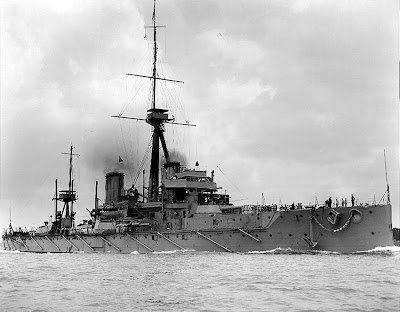HMS Dreadnought (Battleship, 1906-1922), an 18,110-ton battleship built at Portsmouth Dockyard, England, represented one of the most notable design transformations of the armored warship era. Her "all-big-gun" main battery of ten twelve-inch guns, steam turbine powerplant and 21-knot maximum speed so thoroughly eclipsed earlier types that subsequent battleships were commonly known as "dreadnoughts", and the previous ones disparaged as "pre-dreadnoughts". The swiftness of her construction was equally remarkable. Laid down in October 1905, she was launched in February 1906, after only four months on the ways. Dreadnought was commissioned for trials a year after her keel was laid and was completed in December 1906. Her building, trials and early service were closely watched by the World's naval authorities, including the U.S. Navy's Office of Naval Intelligence, the source of all of our photographs of Dreadnought.
The new battleship served as Flagship of the Home Fleet in 1907-1912 and remained part of that fleet thereafter. Dreadnought served with the 4th Battle Squadron in the North Sea during the first two years of World War I. On 18 March 1915, while so employed, she rammed and sank the German Submarine U-29. From May 1916, Dreadnought was flagship of the 3rd Battle Squadron, based on the Thames to counter the threat of bombardment by German battlecruisers. Placed in reserve in 1919, the once-revolutionary warship was sold for scrapping in 1922.
HMS Dreadnought (British Battleship, 1906) Underway, with an anchor suspended from the starboard deck edge, circa 1906-07.
Note the array of booms used to deploy her anti-torpedo net system. Photo #: NH 63596 U.S. Naval History & Heritage Command Photograph.
This is a World Wide Web site for official information about the Naval History and Heritage Command (NHHC) and naval history. It is provided as a public service by the NHHC. The purpose is to provide information and news about the Naval History and Heritage Command and naval history to the general public.
All information on this site is in the public domain and may be distributed or copied unless otherwise specified. Use of appropriate byline / photo / image credits is requested.
This file is a work of a United States Department of Defence employee, taken or made during the course of the person's official duties. As a work of the U.S. federal government, the file is in the public domain.
Generally speaking, works created by U.S. Government employees are not eligible for copyright protection in the United States. See Circular 1 "COPYRIGHT BASICS" PDF from the U.S. Copyright Office. +sookie tex
TEXT and IMAGE CREDIT: Naval History and Heritage Command
Pin It














No comments:
Post a Comment